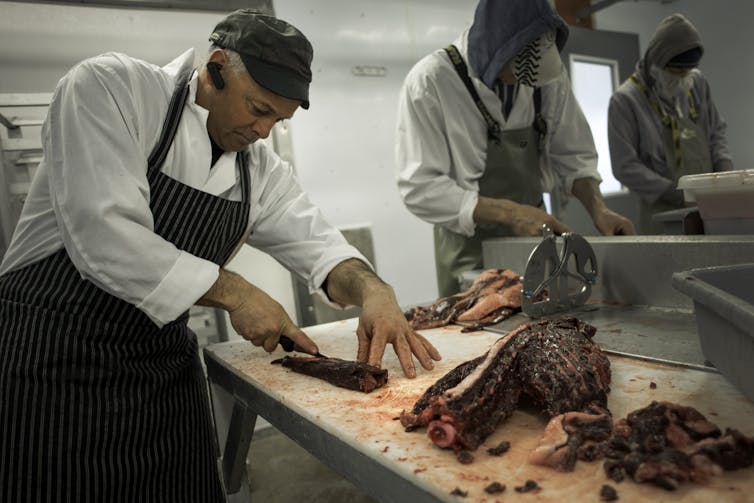There is growing interest in the commercialization of grey seal (Halichoerus grypus) products from the Gulf of St. Lawrence. While seal fur has been sold and blubber processed into oil for a long time, few markets exist for seal meat and organs. However, over the past ten years, small businesses in the Magdalen Islands have been offering these products based on sustainable practices, contributing to the sound management of this resource in the St. Lawrence.
A dark meat with a salty and unique taste, grey seal is appreciated by wild meat aficionados. Grey seal meat and liver are commonly prepared as tataki, filets, sausages, or pâté, and are increasingly being consumed by hunting families in coastal communities as well as sold in Québec’s gourmet restaurants.
As experts in ecotoxicology, environmental health and wildlife pathology, we set out to study the nutritional value of seal meat and organs, as well as the chemical contaminants and pathogens that may be present in these products.
Interested in trying grey seal? Here is a short guide to making informed choices.

This article is part of our series, The St. Lawrence River: In depth. Don’t miss new articles on this mythical river of remarkable beauty. Our experts look at its fauna, flora and history, and the issues it faces. This series is brought to you by La Conversation.
A non-threatened species
As part of their traditional way of life, the Magdalen Islanders hunted seals for food and fur until the nineteenth century. To this day, the activity remains at the heart of their culture, contributing significantly to the local economy of the Magdalen Islands and other communities along the shores of the St. Lawrence.
There are around a thousand commercial hunters who are active each year and recreational hunting of grey seal is also permitted. Despite a recent surge in hunting activity, these hunts do not threaten the status of this population, which has been designated “not at risk”. There are an estimated 340,000 grey seals that live in Eastern Canada, including the Gulf of St. Lawrence.
The dose makes the poison
Naturally present in the environment at low concentrations, certain chemical elements, such as copper and iron, are nutrients that are necessary for the proper functioning of living organisms. But, in some cases, these “essential” elements can reach high concentrations that are potential health risks.
Some organisms can also accumulate high concentrations of “non-essential” trace elements, including chemical contaminants such as mercury, cadmium and lead. These have no biological function and are toxic at very low concentrations for both seals and humans.
Results of our initial study show that grey seal meat and liver can be a good source of nutrients, particularly iron and copper. This study suggests that the best practice is to eat the muscle, heart, and liver from weaned seals that are less than six weeks old. Why? Because the levels of essential and non-essential elements measured for this age group did not exceed any of the maximum recommended concentrations for weekly consumption, even for the most vulnerable populations — pregnant women and young children.
In support of young seal consumption
Grey seals begin feeding at sea at around six weeks old, and this is when we found that the concentrations of mercury and cadmium increased in meat and liver. For seals, most trace elements are absorbed from food and so these results probably reflect the change in diet after weaning. While these concentrations do not pose significant risks to the general population, greater vigilance is advised for pregnant women and young children.

The view of the Gaspésie-Îles-de-la-Madeleine Regional Public Health Department is that Health Canada’s recommendations for the consumption of canned albacore tuna for pregnant women and young children should also apply to grey seals from the Gulf of St. Lawrence. Albacore tuna has intermediate mercury concentrations similar to those measured in the muscle and liver of grey seals six weeks and older.
Seal kidneys should be avoided, however, due to higher concentrations of cadmium and mercury. This is the case for both seals less than six weeks old and older seals. High levels of lead were also found in a few grey seals. These findings highlight the importance of promoting lead-free and non-toxic ammunition for hunting, for environmental reasons and to avoid meat contamination.
Although both juvenile and adult grey seals are hunted for meat, the commercial hunt for seal organs targets only weaned pups younger than six weeks. Our study confirms that this commercial practice is appropriate for human consumption.
Low risk of parasite transmission
A second study evaluated the presence of five infectious agents, namely bacteria and parasites that can be transmitted to humans by grey seals during the preparation or consumption of raw or undercooked meat. Such “zoonotic” infections are also possible through contact with livestock and poultry, as well as with various wild animals in North America.
The good news is that the parasite Trichinella (which causes trichinellosis) was not detected in any of the sampled seals. In addition, very few seals showed signs of infection with Brucella bacteria (which causes brucellosis) and Erysipelothrix rhusiopathiae (associated with seal finger infection).
However, all seals showed signs of exposure to the bacterium Leptospira interrogans (responsible for leptospirosis), and half of the seals tested carried the parasite Toxoplasma gondii (which causes toxoplasmosis).
Taking precautions
But don’t panic. Canadian standards for the handling and slaughter of food animals guarantee healthy products from the commercial seal hunt, especially when combined with proper cooking practices. Moreover, it is recommended that all hunters wear disposable gloves when handling seals to avoid contact with bacteria.
To reduce the risk of infection by Toxoplasma gondii, commerically hunted seal meat and liver is always frozen at -10C or less for three days before going to market, which destroys the parasite. For recreational hunters, this practice is highly recommended, especially when the meat is eaten raw or undercooked, such as in tataki (the best way to eat it, according to the chefs!). Thoroughly cooking seal meat to an internal temperature of 74C should also inactivate any pathogens.

It should be noted that unlike pathogens, chemical contaminants (mercury, lead, cadmium) are not destroyed by freezing or cooking.
Science serving communities
By working in collaboration with hunters and local decision-makers, our work contributes to putting science at the service of communities to promote sustainable management, and the healthy consumption of this unique St. Lawrence resource.
How can we make informed choices when eating grey seal products? Choose the meat, liver and heart of young seals (less than six weeks old) and apply standard sanitary measures (gloves, freezing or thorough cooking) when handling seals and their products.
Would you like to taste seal meat or other products from the St. Lawrence? Visit the Manger notre Saint-Laurent website to discover where to buy them.
Contact with nature is also good for your health! The Exploramer Museum in Sainte-Anne-des-Monts offers a complete training course on seal hunting. This workshop is given by Réjean Vigneau, an experienced hunter and owner of the Boucherie Côte à Côte in the Magdalen Islands, and Yannick Ouellet, a local chef.
"seal" - Google News
September 01, 2022 at 01:32AM
https://ift.tt/olFDNnh
What you should know about eating grey seal meat and products from the Gulf of St. Lawrence - The Conversation
"seal" - Google News
https://ift.tt/fa04VCi
https://ift.tt/Zf17DWV

No comments:
Post a Comment